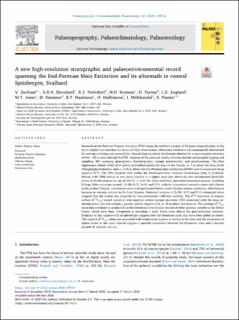| dc.contributor.author | Zuchuat, Valentin | |
| dc.contributor.author | Sleveland, Arve | |
| dc.contributor.author | Twitchett, Richard | |
| dc.contributor.author | Svensen, Henrik | |
| dc.contributor.author | Turner, Holly E | |
| dc.contributor.author | Augland, Lars Eivind | |
| dc.contributor.author | Jones, Morgan Thomas | |
| dc.contributor.author | Hammer, Øyvind | |
| dc.contributor.author | Hauksson, Bjarki | |
| dc.contributor.author | Haflidason, Haflidi | |
| dc.contributor.author | Midtkandal, Ivar | |
| dc.contributor.author | Planke, Sverre | |
| dc.date.accessioned | 2021-04-27T12:20:48Z | |
| dc.date.available | 2021-04-27T12:20:48Z | |
| dc.date.created | 2020-11-11T19:27:08Z | |
| dc.date.issued | 2020-09-15 | |
| dc.identifier.issn | 0031-0182 | |
| dc.identifier.uri | https://hdl.handle.net/11250/2739931 | |
| dc.description.abstract | Research on the Permian-Triassic boundary (PTB) along the northern margins of Pangaea (exposed today in the Arctic region) has been heavily reliant on field observations, where data resolution was consequently determined by outcrop condition and accessibility. Core drilling in central Spitsbergen allowed for a near-complete recovery of two ~90 m cores through the PTB. Analyses of the core and nearby outcrops include stratigraphic logging and sampling, XRF scanning, petrography, biostratigraphy, isotope geochemistry, and geochronology. The First Appearance Datum (FAD) of H. parvus in Svalbard places the base of the Triassic ca. 4 m above the base of the Vikinghøgda Formation, and ca. 2.50 m above the End-Permian Mass Extinction (EPME) and its associated sharp negative δ13C. The PTB therefore falls within the Reduviasporonites chalastus Assemblage Zone in Svalbard. Precise U-Pb TIMS dating of two zircon crystals in a tephra layer just above the first documented Hindeodus parvus in Svalbard gives an age of 252.13 ± 0.62 Ma. High-resolution palaeoenvironmental proxies, including Si/kcps (kilo counts per second), Zr/Rb, K/Ti, Fe/K, and V/Cr, indicate a transition towards a more arid climate in the earliest Triassic, contemporaneous with prolonged bottom-water dysoxic/anoxic conditions, following an increase in volcanic activity in the Late Permian. Statistical analysis of Zr/Rb, K/Ti and V/Cr elemental ratios suggests that the system was impacted by long-eccentricity (400 kyr) cyclicity. The δ13C excursion in organic carbon (δ13Corg) record signals a large negative carbon isotope excursion (CIE) associated with the mass extinction event, but also records a second, smaller negative CIE ca. 22 m above this interval. This younger δ13Corg excursion correlates to similar CIEs in the Dienerian (late Induan) records of other sections, notably in the Tethys Ocean, which have been interpreted as recording a small biotic crisis during the post-extinction recovery. Evidence of this negative CIE in Spitsbergen suggests that the Dienerian crisis may have been global in extent. The negative δ13Corg values are associated with evidence for dysoxia or anoxia in the core, and the occurrence of tephra layers in the same interval suggests a possible connection between the Dienerian crisis and a discrete episode of volcanic activity. | en_US |
| dc.description.abstract | A new high-resolution stratigraphic and palaeoenvironmental record spanning the End-Permian Mass Extinction and its aftermath in central Spitsbergen, Svalbard | en_US |
| dc.language.iso | eng | en_US |
| dc.publisher | Elsevier | en_US |
| dc.relation.uri | https://www.sciencedirect.com/science/article/pii/S0031018220301772#bi0005 | |
| dc.rights | Navngivelse 4.0 Internasjonal | * |
| dc.rights.uri | http://creativecommons.org/licenses/by/4.0/deed.no | * |
| dc.title | A new high-resolution stratigraphic and palaeoenvironmental record spanning the End-Permian Mass Extinction and its aftermath in central Spitsbergen, Svalbard | en_US |
| dc.type | Journal article | en_US |
| dc.type | Peer reviewed | en_US |
| dc.description.version | publishedVersion | en_US |
| dc.rights.holder | Copyright 2020 The Authors | en_US |
| dc.source.articlenumber | 109732 | en_US |
| cristin.ispublished | true | |
| cristin.fulltext | original | |
| cristin.qualitycode | 2 | |
| dc.identifier.doi | 10.1016/j.palaeo.2020.109732 | |
| dc.identifier.cristin | 1847140 | |
| dc.source.journal | Palaeogeography, Palaeoclimatology, Palaeoecology | en_US |
| dc.source.pagenumber | 1-22 | en_US |
| dc.relation.project | Lundin Norway: 421269 | en_US |
| dc.identifier.citation | Palaeogeography, Palaeoclimatology, Palaeoecology. 2020, 554, 109732 | en_US |
| dc.source.volume | 554 | en_US |

